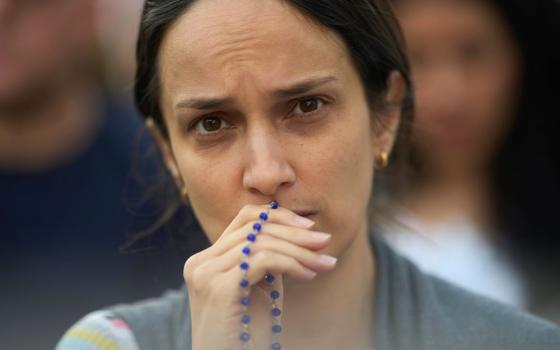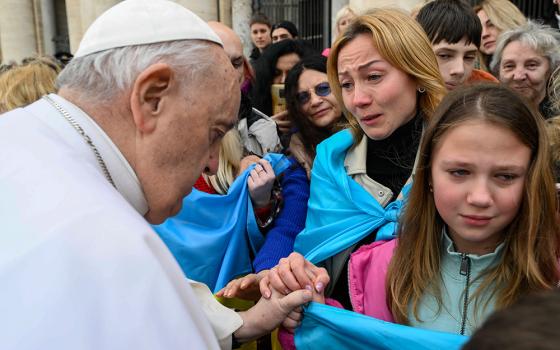Yesterday, the dam broke. In comments made to Kevin Clarke at America magazine, Bishop Stephen Blaire of Stockton, with carefully selected words and a persuasive and important argument, explained his differences of opinion with some of his brother bishops regarding the best way to address the religious liberty concerns the bishops all share.
Here is the key part of the interview:
He said there are other bishops who see the crucial question as the religious liberty of the church itself and its freedom “to exercise her mission through her institutions.” He added, “I think that it’s important that there be a broader discussion of these issues [at the June U.S. bishops meeting in Atlanta]” so that U.S. bishops can clarify their message “and not allow it to be co-opted.”
“I am concerned that in addressing the H.H.S. mandate,” he said, “that it be clear that what we are dealing with is a matter of religious liberty and the intrusion of government into the church and that it not be perceived as a woman’s issue or a contraceptive issue.
“I think there are different groups that are trying to co-opt this and make it into political issue, and that’s why we need to have a deeper discussion as bishops.”
There are two key points here, and I happen to agree with Blaire on both of them. First, the bishops have to decide whether or not this is a fight about individual conscience rights or a fight about the rights of the Church. Second, the bishops have to decide if they are going to reduce their concern about religious liberty to a struggle against the HHS mandate, and risk looking like partisans, or instead address the issue of religious liberty in its fullness. On Monday, and many times previously, I addressed this second point and warned the USCCB against appearing partisan. Yesterday, I noted that at a panel at the National Press Club sponsored by Catholic University, all four legal scholars were in agreement that the first recent threat to religious liberty emerged not from the Obama White House but from the pen of Justice Antonin Scalia in his 1990 decision in Employment Division v. Smith. That was as much or more of an “unprecedented” threat to religious freedom as anything to come out of HHS.
The first point has also been the subject of more than a little commentary on this blog. In January, when the President first announced his decision not to expand the exemptions from the HHS mandate, Catholics across the political spectrum were generally in agreement that the Church and her institutions should not be forced to participate in the mandate against their will. Then, after the first accommodation was announced – and accommodation I must repeat that did not satisfy my concerns precisely because it left the onerous definition of what is and is not a religious organization in place – the USCCB began talking about the need for an exemption for individuals, not just for religious organizations. You can cherry pick a couple of sentences out of Dignitatis Humanae, the Second Vatican Council’s Decree on Religious Liberty, to justify such a stance, but my fear then, and apparently Blaire’s fear now, is that by emphasizing the right to individual conscience rights, in a culture which understands conscience differently from the way Catholics understand it, the USCCB was unintentionally “feeding the beast” of libertarianism in a political culture where libertarianism is the cancer that most afflicts our Catholic understanding of the Common Good. For us, conscience is the voice of God speaking to us about our moral obligations in the concrete circumstances of our lives. In the ambient culture, conscience is private judgment. Why would the USCCB support an argument that sides with the sixteenth century Reformers on the central issue of their day and our day: Is truth someone we discern and discover, and always together, or is it something we manufacture on our own?
The other key point Blaire made is that the lawsuits filed Monday are in no sense a slam dunk. He noted that the California Catholic Conference had brought a similar suit against a similar state-level mandate and lost. The litigants make a great case, but there is a legal case to be made on the other side as our nation continues to wrestle with the legal implications of the First Amendment and, specifically, with the inherent tension between the establishment clause and the free exercise clause. If the lawsuits filed Monday fail, the Church will have a legal precedent to overcome in the future, not just an HHS mandate.
What is fascinating about Blaire’s comments to America, however, is not so much this point or that point. What is significant is the fact of his comments. For years, most bishops worked through the USCCB and its often laborious processes, building consensus slowly but ending with a statement or document that allowed the hierarchy to speak with one voice. Occasionally, and to much media fanfare, more conservative bishops would speak out on their own in contradiction to what was coming from the USCCB. We all remember Bishop Martino in Scranton refusing to discuss a USCCB document and telling a group of Catholic lay people that the conference had “no authority” within his diocese.
Shortly after the 2009 fracas over the President’s appearance at Notre Dame, in an interview with my colleague Tom Roberts, Archbishop Michael Sheehan of Santa Fe discussed this tension within the conference and said that he believed the majority of bishops were opposed to the more aggressive tactics employed by those who denounced Notre Dame. He acknowledged that the outspoken bishops may get the headlines, but that most bishops continued to prefer collaboration and consultation and moving forward together. “The bishops don’t want to have a battle in public with each other, but I think a majority of bishops in the country didn’t join in with that [the public denunciations], would not be in agreement with that approach,” Sheehan said. “It’s well intentioned, but we don’t lose our dignity by being strong in the belief that we have, but also talking to others who don’t have our belief….We’d be like the Amish, you know, kind of isolated from society, if we kept pulling back because of a single issue.” That was 2009, when Archbishop Chaput was still in Denver and Archbishop Lori was still in Bridgeport and when Bishop Kicanas was expected, like all previous VPs of the conference, to move up to the top slot the following year. It was only a matter of time before some of the less arch among the bishops went public with their concerns the way conservative bishops did in previous times when they thought the conference was too moderate. This is the dam that was waiting to be broken, and Blaire’s comments broke it.
It is not a surprise that bishops disagree with one another. At Nicaea, legend has it, bishops pulled each others’ beards. It is undoubtedly the case that at the end of the nineteenth century, the bishops of the U.S. were engaged in a profoundly nasty fight with each other, with the German prelates and Archbishop Michael Corrigan of New York on one side and St. Paul Archbishop John Ireland, CUA’s first rector John Keane and NAC rector Denis O’Connell, later the bishop of Richmond, on the other side. They fought over the school question, over the number of German prelates to be appointed to the hierarchy, over the establishment of an apostolic delegation, over the rights of labor and whether or not “secret societies” should be condemned. The fights often got nasty. At one point during the discussions in Rome over a French translation of a biography of Father Hecker, the founder of the Paulists, a discussion that led to Pope Leo’s condemnation of “Americanism” as a heresy, Denis O’Connell wrote to Walter Elliot of the Paulists. O’Connell had this to say about his opponents: “These men are not honest, and it is an illusion to treat them so.” After the condemnation, in Testem Benevolentiae, Ireland wrote to O’Connell: “nothing is heard of ‘Americanism – No one seems to know that the Pope ever wrote – outside of Corrigan and the Jesuits – who gloat over their supposed triumph. Corrigan imagines he is forever ‘cock of the walk.’ Can you with any kind of stick haul him down? Try.”
The correspondence between the episcopal protagonists in the later nineteenth and early twentieth century makes for some fascinating reading. But, these were private letters and the divisions within the hierarchy were not as likely to make it into the public square as in our own day, when bishops blog and the media has its sources. But, what is clear now, is that the principal challenge facing Cardinal Timothy Dolan as he seeks to lead the USCCB, is not how to combat the HHS mandate. The principal challenge is how to build unity within an episcopal conference that has deep ideological divisions. Dolan must look to the lessons and memories of Gibbons and Mooney and Bernardin, if not for their ideas, for their gift for leadership. It may require the USCCB to be a little less full-throttled in its denunciations of the HHS mandate, a little more full-throttled in its advocacy of immigration reform, and most importantly, a little more focused not on the changing political landscape but on the need to re-evangelize a culture and an American Church that must overcome the acids of modernity that has eaten away not only at this belief or that, but at the disposition to believe itself. It may be time for the USCCB to take a few steps back, and find out what they can agree on, and not by a slim majority but with virtual unanimity. And, this must come from the bishops, not from the staff at the conference. If there is any person within the conference who can avoid a new round of divisiveness, I suspect it is Cardinal Dolan. But, he will need to listen to Mary Ann Glendon and Robbie George and Carl Anderson less, and look to the example of Gibbons more.



